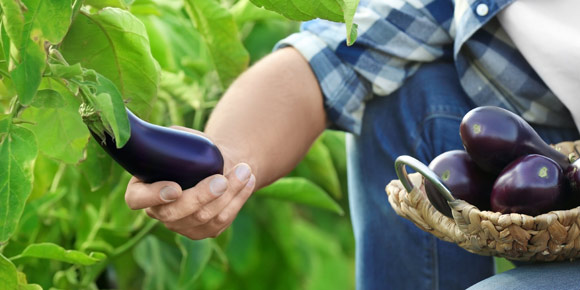For you vegetable gardeners who are thinking about new challenges for next spring, you might want to consider growing eggplant. It’s not what I would call a natural for the Manitoba climate, but neither are tomatoes, to which, eggplants are related. Just don’t plant them with tomatoes or even peppers or potatoes. Because they are all related means they are all susceptible to the same diseases. Eggplants are also attractive to potato beetles, flea beetles, aphids and spider mites and vulnerable to verticillium fungal disease.
Start eggplant seeds eight weeks before planting them out, after which the eggplant will take another 60 to 70 days to ripen. Flowers are star-shaped and white to purple in colour.
When ready to transplant in the garden, set them out about two feet apart. Dig shallow holes which you can fill with water and once the water has drained, add the seedlings. You might like to cut the bottom of a paper cup and insert the cup around the planting to keep the cut worms at bay.
They like rich, humus-y soil supplemented by slow- release 5-10-5 fertilizer to give the fruit-setting a boost.
When your eggplant flowers, pluck off all but five or six of the blossoms form each plant to allow the plant to nourish the best harvest. Use the fruit from the main stem when it is still shiny.
Eggplant was not always a desired vegetable. They were originally called Madde apple and apple of insanity, perhaps because the undercooked seeds of the wild plant are said to have psychotropic properties. The seeds also contain low amounts of nicotine – not much. It would take about 20 pounds of eggplant to equal the hit delivered by one cigarette.
The botanical name, Solanum melongena, for this nightshade family plant seems to ring with a certain Italian music, maybe because it is so highly prized there, and in India (where it originated) it is melogene. The British call it aubergine, supposedly from the French alberge for peach-like; in South Africa, and other widely scattered countries, it is called brinjal. Other fanciful names include thorn apple, bitter apples, bitterball, garden egg and Guinea squash.
Eggplant use has been traced back to 544 A.D. in China where it was written about in an ancient Chinese treatise. It was used by fashion-conscious Chinese women to polish their teeth to a gleaming, metallic black! A Japanese proverb claimed that “the happiest omen for a New Year is first Mount Fuji, then the falcon, and lastly eggplant.” It is also known as the king of vegetables.
It’s not that eggplant delivers a particular wallop in any one nutritional category, although it does have a lot of the B vitamins, a decent amount of manganese and some copper, but what it does have is a very wide array of nutrients in varying amounts. As a bulking agent in the diet, it produces a feeling of being full even though one cup of raw eggplant contains only 20 calories. It is also touted as being a cholesterol-lowering food. The anthocyanins in black-skinned varieties present a potent antioxidant that is known to protect brain cell membranes from damage.
Eggplant, like its cousin the tomato, is a fruit. It carries its seeds dispersed throughout its flesh and so is technically a berry. As some people point out, “Knowledge is knowing that eggplant is a fruit; wisdom is not using it to make a fruit salad.”
Here in North America, we see eggplants as a largish, swollen purple thing with a shape somewhat like a teardrop. Around the world this fruit can be many shapes, from round to oval, to long and slender, to segmented like a heritage tomato, and occurring in many different sizes, shapes and colours. Some are white, some yellow or orange. Many long skinny ones are green. Some are striped, some are almost black, some have wrinkled skin like a bitter melon. There also many sizes, from small, white and egg-shaped (hence the name) to the large varieties we often see at the supermarket.
When shopping for eggplant, look for glossy, unbruised fruit that is heavy and has bright green stems at both ends. If it is fresh, the flesh will spring back from a thumbprint. Do not buy waxed fruit. Eggplant is sensitive to heat and cold, so store at about 10° C and do not store cut fruit as it goes bad quickly (cut pieces will oxidize and turn brown). Do not wash before storing. Cut using stainless steel. It will turn carbon steel black.
Eggplant, especially the seeds, can be a little bitter. One way to deal with this is to salt the slices and let them sit for about 30 minutes. They can then be rinsed to remove any salt residue. This also has the effect of making them less permeable to fat if you decide on frying as the cooking method.
Juice from eggplant roots was used to treat throat, stomach, coughs, rheumatism and toothaches. Counter-intuitively, eggplant extract was also used to treat asthma and skin problems, although about 10 per cent of the population develops allergy symptoms when exposed to eggplant, which is high in histamines.
Now that you have all the information, put eggplant on your growing list for next year, and if all this seems a little daunting, experiment with one of the dwarf varieties in a pot, already well started by your local nursery.
Dorothy Dobbie is the publisher of Manitoba Gardener magazine, celelbrating its 20th anniversary. For a subscription go to localtgardener.net or call 204-940-2700 and Shelly will e happy to take your order. Listen to Dorothy on Sunday mornings at 8:00 on CJNU. 93.7 FM.



